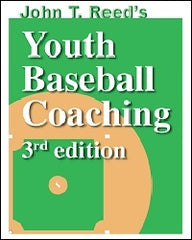All baseball and softball players should bat left-handed, not right or switch
Posted by John T. Reed on
My first baseball coaching book came out in 2000. It said to bat left handed, not right-handed, no matter which is your dominant hand and that switch hitting was a waste of time, especially at the amateur level where about 90% of the pitchers are right-handed.

The 7/25/18 Wall Street Journal has an article titled “Lost Art of Switch Hitting.” Google the title to read it. It’s subtitle ends with, “it isn’t really worth the extra effort.”
Told ya.
I ran into my neighbor Tony LaRussa at the local gas station once. I sent him an article I wrote on batting left-handed only. He wrote back that he agreed generally but liked to have switch hitters to make the tactical maneuver of having them bat opposite-handed of the pitcher. There are only two benefits of opposite handed batting. One is they make the curve and slider easier to hit because they break toward the opposite-handed batter.
The other is they can pick up the release point of the pitch earlier.
So even Tony needed to read my book.
The Journal article authors also need to read my book. They made the mistake of calling Chipper Jones’ right side his “natural” side. There is no such thing. Right handed batters do that because they were told to by ignoramuses who also need to read my book. It is a two-handed activity, like swinging an ax.
To figure out a kid’s natural side, you would need to put him on a desert island with nothing but a pitching machine and a continuous loop video showing a left-handed then a right-handed batter. Then see which the kid chooses. That has never been done. Everyone bats from the side their father or playmate told them to.
One item in the article that I never thought about is the high percentage of defensive shifts now in MLB hurts left-handed batters more.
But the Journal authors and the MLB people they talked to still got it wrong. They still think hitters should bat from their “natural” side. Idiots.
1. All four bases are 18 inches closer to the left-handed batter’s box
2. Finish swing facing first base
3. See right-handed pitcher’s release point better
4. Home plate does not need to be stepped over on the way to first
5. Can drag bunt
6. better for pull hitters to hit toward right field than left so runner at first can get to third
7. Easier to hit curves and sliders thrown by 90% of the pitchers (right-handed pitchers)
8. Block catcher’s line of sight to the runner at first
9. Block right-handed catcher’s throwing arm
A study once said opposite eye-dominant batters did better (dominant eye closest to the pitcher better). A later, better study found that was incorrect.
Here is the shocking killer stat on this subject:
The incidence of the six possible combinations in MLB position players not pitchers.
Combo MLB General population
BR/TR 61% 89%
BR/TL 1% .1%
BL/TL 13% 8%
BL/TR 17% .001% The winner!
BB/TR 7% 1%
BB/TL .2% .1%
Obviously letting your child or grandchild or players on a team you coach bat right-handed or switch hit is malpractice. I and my two oldest sons are BR/TR. By the time my youngest son came along, I had figured it out. He is BL/TR, as is my 7-year-old granddaughter and as will be my 2-year-old grandson when he starts to play.
Failure to have those you coach bat left handed will have the following results throughout their career:
• less likely to get on base in a given at bat
• lower batting average
• lower Bill James Runs Created
• less likely to get picked for youth majors
• less likely to be first string on every team played on
• less likely to make all-stars at all levels (I made that in spite of batting right in Little League)
• less likely to make the high school team
• less likely to be recruited by a college baseball coach
• less likely to be drafted by the MLB
• less likely to make the Hall of Fame, which Chipper did
Like I said, malpractice. How can you live with yourself?
Share this post
0 comment
